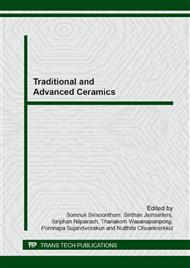p.132
p.141
p.147
p.153
p.159
p.164
p.170
p.175
p.181
Morphology Controlled Flower-Like ZnO Particles Synthesized by Low Cost High Pressure Cooker
Abstract:
ZnO is a good candidate material for many optical and optoelectronic applications. ZnO with various shapes and sizes can be prepared via chemical methods such as precipitation, microwave heating and hydrothermal method. Generally ZnO synthesized by hydrothermal method uses autoclave which is expensive and gives low % yield. This research applied a low cost high pressure cooker which replaced the use autoclave to synthesize ZnO as its concept is similar to hydrothermal method. In this study, it was found that the size and shape of the synthesized ZnO particles were affected by several factors such as Zn2+/OH- ratio, temperature and time. Zinc nitrate hexahydrate, Zn(NO3)2.6H2O and sodium hydroxide, NaOH were used as metal ion sources in the precursor solutions. Structural and morphological studies were performed by X-ray diffraction (XRD) and scanning electron microscope (SEM). The effect of Zn2+/OH- ion ratios, hydrothermal temperature and time on the size and morphology of ZnO were discussed in detail. All the synthesized conditions yielded hexagonal wurtzite structure of ZnO confirmed by XRD, without calcinations process. SEM images showed plate-like structure for Zn2+/OH- ratio = 1:7.5 and 1:15 and flower structure for Zn2+/OH- ratio = 1:20. Sizes of the synthesized ZnO particles decreased with increasing hydrothermal temperature from 120 to 200°C. The longer the synthesized time period the larger the ZnO particles obtained.
Info:
Periodical:
Pages:
159-163
Citation:
Online since:
April 2014
Keywords:
Price:
Сopyright:
© 2014 Trans Tech Publications Ltd. All Rights Reserved
Share:
Citation:


